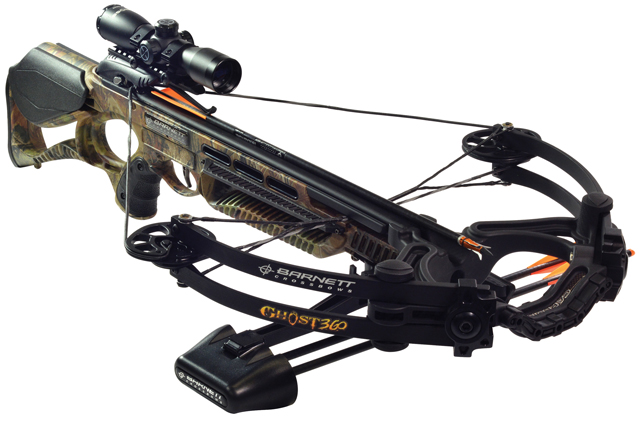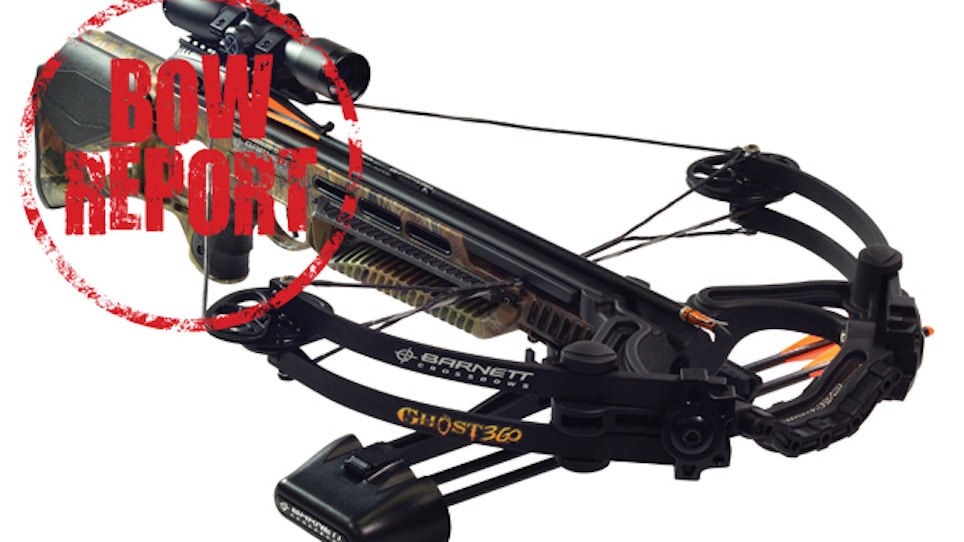The Ghost 410 is one of nine bows in Barnett’s Carbonlite series. Modeled after the popular Ghost 400, it features a Carbonlite riser and CNC machined aluminum flight rail, as well as a 7⁄8-inch Picatinny Rail and composite laminated limbs. The 410 boasts significant improvements over its predecessor, most notably a mass weight that is a full pound lighter at 7.2 pounds, and two inches narrower at 22 inches. And as the name suggests, the 410 is 10 fps faster than the 400.
Another difference between the Ghost 400 and the Ghost 410, this one obvious at a glance, is the pass-through design that allows the shooter to put his fingers through the forgrip. Like the Ghost 400 and Barnett’s other Carbonlite bows, the Ghost 410 is constructed with Barnett’s Shoot Thru Riser design, which allows for a longer draw stroke than crossbows with similar dimensions and which, together with the Carbonlite riser itself, helps keep the balance point back toward the shooter’s shoulder. Also contributing to the compact length (relative to the power stroke) and the balance is Barnett’s extended trigger system, which involves a transfer bar from the trigger itself to the firing activator. In addition, the Ghost 410 employs Barnett’s anti-dry-fire device that prevents firing the crossbow without a bolt in place.
The R.T.H package tested includes a compact Barnett 3-arrow quiver, a non-slip Talon sling with a quick-release feature, three 22-inch carbon bolts, a rope cocking device, and a 3x32 Multi-Reticle Illuminated Scope with see-through lens covers. Mysteriously not mentioned on the packaging or in any of the provided literature is a welcome option in the form of an extended butt plate, giving users the choice between the installed butt plate or a thicker version for shooters who wish to extend the crossbow’s overall length by an inch or two. Also not mentioned but included in the RTH package is an extra tongue for the anti-dry-fire device, presumably for replacement should the original be damaged. Not included in the package, but available as a separate option, is Barnett’s Crank Cocking Device, which can be easily integrated into the stock of the crossbow.
With the exception of the safety, a few small washers, and relatively small nicely contrasting logos, the Ghost 410 is a matte black with excellent fit and finish. The scope, too, is black, and even the strings and cables are black and gray.
Assembly
Assembling the Ghost 410 is as simple as placing the cables under the flight track with the string atop it, seating the bow limb assembly, and putting a bolt with a washer through a bushing and tightening it. Installing the scope and sling are equally straightforward and simple, and the whole operation can be completed in a matter of minutes. Necessary hex keys and wrenches are provided.
Shooting The Bow/General
Observations
Though objective testing is done off the bench, I always begin and end a shooting test by shouldering the crossbow and shooting off hand. Weight and balance are always immediately noticeable, and while at 7.2 pounds (minus accessories) this is not a truly light crossbow by current standards, it is very well balanced. The grip is very ergonomic—both the grooved, cushioned grip behind the trigger and the pass-through foregrip. To some extent this is a subjective observation, as the comfort will depend to some degree on how well this bow fits the shooter. Still, it’s difficult to imagine that the great majority of shooters would not find the Ghost 410 to be a very comfortable bow to hold off hand. In a similar vein the cheek piece, designed to accommodate the optional crank cocker, is slightly raised in a fashion similar to a Monte Carlo stock on a rifle. I found this positioned my eye at the perfect level to see through the scope.

The scope functioned perfectly, with red and green illumination, each offering five levels of adjustment to match lighting conditions. Rotating a rheostat on the side of the scope accomplishes the adjustment, with the dial stopping firmly but silently at each level. At the center of each of five reticles is a small circle, declining in size from top (close range) to bottom (most distant range). The top circle perfectly encloses a four-inch bull’s-eye at 20 yards, so the circles can serve as aids in ranging targets. The included see-through lens covers are a welcome feature, and I would be inclined to hunt with these in place as light levels permit.
I have two pet peeves about many battery-operated hunting accessories. One is that too many of them are too easily turned on by accident, draining the battery so the device is inoperative when you need it. The other concerns devices that use unusual, hard-to-find, or very expensive batteries. I was pleased to note that the illumination function of the scope provided with the Ghost 410 was not easily turned on by accident, and that the battery is the very common, inexpensive CR2032.
The rope cocker works well. Initially I noticed that as I brought the string up to engage the cocking mechanism, the hooks clacked against the bottom of the scope mount to clear it. This is solved simply enough by turning the hooks so they face upward (with the openings of the hooks facing away from the barrel). This is important, because it is possible to cock the crossbow without engaging the safety if the hooks are facing the wrong way.
After sighting in, I had no difficulty placing four bolts within a couple inches of dead center shooting off hand. Shooting off a bench, even using our standard test bolts (which are not the 22-inch 400-grain bolts recommended by or supplied with the Ghost 410), I found this to be a very forgiving and accurate crossbow. Though literature included with the scope makes some reference to adjustments for parallax, I did not encounter a problem shooting out to 60 yards.
Trigger pull on the Ghost 410 at 3.5 to 4 pounds is not super light, but is consistent and smooth, with no noticeable creep. For me trigger pull was not an issue with this crossbow, and when it comes to trigger pull, “not an issue” is all I require from a crossbow. And, as the objective test data indicates, as crossbows go this is a very quiet one.
The Barnett 3-arrow quiver is reasonably light and very sturdy. And for hunters such as myself, who prefer not to attach a quiver to the crossbow, it features a sturdy clip so it can be affixed to a belt, backpack, treestand, blind pocket, or even a small tree limb.
Finally, though I am inclined to take advantage of any available rest when shooting a crossbow, the Ghost 410 is one crossbow I would not hesitate to shoot off hand in a hunting situation. At a sizzling 400-plus fps with downrange kinetic energy to spare, and with no detectable loss of forgiveness or accuracy, it’s a more than worthy successor to Barnett’s very popular Ghost 400. And though its price does not put it in the bargain bow category, at a manufacturer’s recommended retail price of $1,199 it is nonetheless a great buy for the money.
Ghost 410 Specs
Draw Weight:......... 185 pounds
Power Stroke:....... 15.375 inches
Kinetic Energy:...... 149 ft. lbs.*
Speed:................... 410 fps
Overall length:....... 37.375 inches
Width:................... 22 inches
Weight:.................. 7.2 pounds
Suggested Retail:... $1,199
*With supplied 22-inch bolts
Objective Tests
Bolt Weight:........... 390 grains...... 450 grains
Speed AL*/20 yards:................... 414/390 fps 385/377 fps
K.E. AL*/20 yards:...................... 147/130 ft. lbs. 148/143 ft. lbs.
Sound Level:.......... 95.9 dBA........ 93.8dBA
*AL is At Launch






